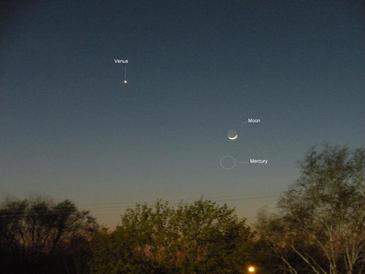-
What's Up?
Stargazing Tips for the week of February 18-24, 2014February 18: Moon and Spica
The Moon is passing through a busy section of sky this week. It will snuggle close to two bright stars and two brighter planets. The action tips off tonight with Spica, the brightest star of Virgo, which is just below the Moon.February 19: Moon and Mars
Mars is in great view tonight. The planet rises above the Moon in late evening and sticks close to the Moon as they climb across the south in the wee hours of the morning. It looks like a brilliant orange star.February 20: Moon and Saturn
Saturn is in fine view early tomorrow. The planet stands to the left of the Moon at first light, looking like a bright golden star. A telescope will reveal the planet’s magnificent rings.February 21: Moon and Companions
The last-quarter Moon has a couple of bright companions in the wee hours of tomorrow morning. The planet Saturn is close to its upper right at first light, with the star Antares a little farther to the lower left.February 22: Lynx
An obscure cat pads through the northern sky at this time of year. Known as Lynx, it stands high in the northeast in early to mid evening, about halfway between the outer stars in the bowl of the Big Dipper and the bright “twins” of Gemini.February 23: Zeta Cas
Cassiopeia, the queen, is in the northwest at nightfall. Its brightest stars form an easy-to-spot letter W. Another bright star is stands below the lower right point of the W: Zeta Cassiopeia. The star is much bigger, hotter, and heavier than the Sun.February 24: Moon and Venus
Look for Venus to the lower left of the crescent Moon beginning a couple of hours before sunrise tomorrow. The beautiful pairing will be even tighter the next day, with the “morning star” to the upper right of the Moon.Stargazing Information from StarDate Online (http://stardate.org) A picture of Venus, Mercury and the Moon taken on 4/15
A picture of Venus, Mercury and the Moon taken on 4/15
Select a School...
Select a School
- Adams Elementary School
- Andover Elementary School
- Brookside Elementary School
- Champlin-Brooklyn Park Academy for Math and Environmental Science
- Crooked Lake Elementary School
- Dayton Elementary School
- Eisenhower Elementary School
- Evergreen Park Elementary: STEM School of Innovation
- Franklin Elementary School
- Hamilton Elementary School
- Hoover Elementary School
- Jefferson Elementary School
- Johnsville Elementary School
- Lincoln Elementary School for the Arts
- Madison Elementary School
- McKinley Elementary School
- Mississippi Elementary School
- Monroe Elementary School - Mathematics, Science and Children's Engineering
- Morris Bye Elementary School
- Oxbow Creek Elementary School
- Ramsey Elementary School
- Rum River Elementary School
- Sand Creek Elementary School
- Sunrise Elementary School
- University Avenue Elementary School - Aerospace, Children's Engineering and Science
- Wilson Elementary School
- Anoka Middle School for the Arts
- Coon Rapids Middle School
- Jackson Middle School - A Specialty School for Math and Science
- Northdale Middle School
- Oak View Middle School
- Roosevelt Middle School
- Andover High School
- Anoka High School - Center for Science, Technology, Engineering, Arts and Math (STEAM)
- Blaine High School - Center for Engineering, Mathematics and Science
- Champlin Park High School - International Baccalaureate Programme
- Coon Rapids High School - Center for Biomedical Sciences and Engineering
- Sandburg Regional High School
- Anoka-Hennepin Technical High School
- Secondary Technical Education Program (STEP)
- Anoka-Hennepin Online
- Compass Programs
- Special Education
- COVID-19 Information
- Fit for the Future projects
- Anoka-Hennepin Community Education
- Staff intranet
- Attendance boundaries
- Referendum 2021

